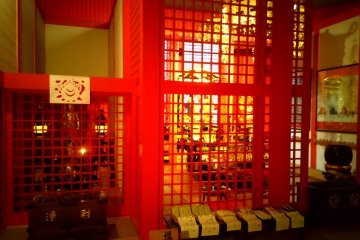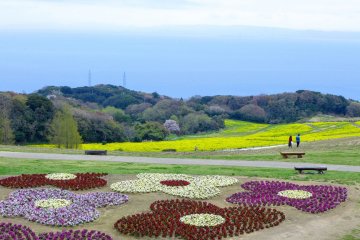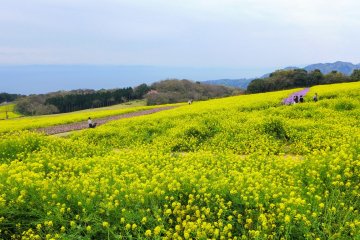Rolling hills of gold, as far as they eye can see. A comfortable silence that is only broken by the chatter of skylarks.

Hanasajiki, or ‘flower gallery’, is a relatively little-known spot to foreign visitors as perhaps is the meaning behind its name. Interestingly, ‘sajiki’ derives from Kabuki Theatre terminology, referring to the raised area of seating usually found on either side of the orchestra, or ‘box seats’. While they share the same physical orientation and social implications as those in Western theatres, they sometimes differ in that guests are seated upon cushions on a floor made of tatami mats, rather than chairs. They are the only remnant of the traditional Kabuki theatre seating style, as after the 19th century the Western style of seating (on uncomfortable tightly packed chairs) was adopted in the rest of the theatre.
The box seat analogy no doubt refers to the raised observatory that you will encounter at the beginning of the flower trail, where you can overlook the flowers as you would a theatre stage. At the top of the wooden structure, you are afforded with an expansive view of the park, which exceeds the size of four baseball stadiums and contains in excess of 2.5 million flowers. Beyond the flowers lies the sea.

In spring the dominant flower is Mustard Seed (nanohana), shot through with streaks of purple Murasaki Hanana and multicoloured plots of Linaria.
The flowers change from season to season, with the Mustard Seed followed by Sunflowers in summer, Cosmos in autumn, and Pansies in winter.

Flower Pilgrims will be delighted to know that Hanasajiki is but one of 70 spots on the Awaji Hana Henro, or Awaji Flower Pilgrimage. From Tadao Ando’s Dream Stage (Yumebutai, ‘butai’ being the term for ‘stage’ in Kabuki Theatre) to the Lotus Temple, one could easily while away a day or more flitting among multi-coloured blooms.












